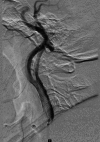Tandem symptomatic internal carotid artery and persistent hypoglossal artery stenosis treated by endovascular stenting and flow reversal
- PMID: 23709141
- PMCID: PMC3669809
- DOI: 10.1136/bcr-2012-010578
Tandem symptomatic internal carotid artery and persistent hypoglossal artery stenosis treated by endovascular stenting and flow reversal
Abstract
Persistence of the hypoglossal artery into adulthood is a rare vascular anomaly and, when present, provides the predominant vascular supply to the posterior circulation. We describe a case of vertebrobasilar insufficiency associated with severe high-grade stenosis of the persistent hypoglossal artery and tandem stenosis of the proximal ipsilateral internal carotid artery, treated by an endovascular approach. The unique anatomical and technical challenges associated with this case are reviewed in detail.
Keywords: Atherosclerosis; Intervention; Stenosis; Stent.
Figures






Similar articles
-
Tandem symptomatic internal carotid artery and persistent hypoglossal artery stenosis treated by endovascular stenting and flow reversal.J Neurointerv Surg. 2014 May;6(4):e25. doi: 10.1136/neurintsurg-2012-010578.rep. Epub 2013 Jun 4. J Neurointerv Surg. 2014. PMID: 24719481
-
Symptomatic internal carotid artery stenosis in the presence of a persistent primary hypoglossal artery.Vascular. 2021 Aug;29(4):543-549. doi: 10.1177/1708538120966514. Epub 2020 Nov 11. Vascular. 2021. PMID: 33175663
-
Persistent primitive hypoglossal artery with retrograde flow from the vertebrobasilar system: a case report.Neurosurg Rev. 2007 Oct;30(4):345-9; discussion 349. doi: 10.1007/s10143-007-0092-6. Epub 2007 Aug 9. Neurosurg Rev. 2007. PMID: 17687575
-
Stenting for Internal Carotid Artery Stenosis Associated with Persistent Primitive Hypoglossal Artery Using Proximal Flow Blockade and Distal Protection System: A Technical Case Report and Literature Review.J Stroke Cerebrovasc Dis. 2016 Jun;25(6):e98-e102. doi: 10.1016/j.jstrokecerebrovasdis.2016.03.026. Epub 2016 Apr 19. J Stroke Cerebrovasc Dis. 2016. PMID: 27105567 Review.
-
A successful treatment with carotid arterial stenting for symptomatic internal carotid artery severe stenosis with ipsilateral persistent primitive hypoglossal artery: case report and review of the literature.Minim Invasive Neurosurg. 2008 Oct;51(5):298-302. doi: 10.1055/s-0028-1082299. Epub 2008 Oct 14. Minim Invasive Neurosurg. 2008. PMID: 18855296 Review.
Cited by
-
Strategy of cerebral endovascular treatment for cervical internal carotid artery stenosis with a persistent primitive hypoglossal artery.Surg Neurol Int. 2023 Sep 1;14:308. doi: 10.25259/SNI_567_2023. eCollection 2023. Surg Neurol Int. 2023. PMID: 37810314 Free PMC article.
-
Internal carotid artery stenosis with persistent primitive hypoglossal artery treated with carotid artery stenting: A case report and literature review.Neuroradiol J. 2016 Apr;29(2):115-21. doi: 10.1177/1971400915626427. Epub 2016 Jan 29. Neuroradiol J. 2016. PMID: 26825135 Free PMC article. Review.
-
Percutaneous transluminal angioplasty for persistent primitive hypoglossal artery stenosis: illustrative case.J Neurosurg Case Lessons. 2023 Oct 23;6(17):CASE23427. doi: 10.3171/CASE23427. Print 2023 Oct 23. J Neurosurg Case Lessons. 2023. PMID: 37871338 Free PMC article.
References
-
- Osborn AG. Diagnostic Cerebral Angiography. Philadelphia: Lippincott Williams and Wilkins, 1999
-
- Megyesi JF, Findlay JM, Sherlock RA. Carotid endarterectomy in the presence of a persistent hypoglossal artery: case report. Neurosurgery 1997;2013:669–72 - PubMed
-
- Pyun HW, Lee DH, Kwon SU, et al. Internal carotid artery stenosis with ipsilateral persistent hypoglossal artery presenting as a multiterritorial embolic infarction: a case report. Acta Radiol 2007;2013:116–18 - PubMed
-
- Hui FK, Schuette AJ, Cawley CM. Endovascular treatment of an aneurysm of a persistent primitive hypoglossal artery with complete resolution of brainstem compressive symptoms: case report. Neurosurgery 2011;2013:E854–7 - PubMed
-
- Agnoli AL. Vascular anomalies and subarachnoid haemorrhage associated with persisting embryonic vessels. Acta Neurochir (Wien) 1982;2013:183–99 - PubMed
Publication types
MeSH terms
Grants and funding
LinkOut - more resources
Full Text Sources
Other Literature Sources
